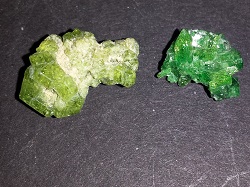A- |
B- |
C- |
D- |
E- |
F- |
G- |
H- |
I- |
J- |
K- |
L- |
M- |
N- |
O- |
P- |
Q- |
R- |
S- |
T- |
U- |
V- |
W- |
X- |
Y- |
Z |
VESUVIANITE:Vesuvianite, also known as Idocrase, is a fascinating mineral found originally on the volcano, Mt Vesuvius, hence one of the names. The other name, idocrase, is from the greek and means mixed form, an allusion to its crystals showing a mixture of other mineral forms. The crystals belong to the tetragonal symmetry class and show a square cross-section perpendicular to the long axis. Tetragonal crystals are uncommon and vesuvianite fortunately produces some very nicely shaped crystals.
Luster is vitreous or greasy to resinous.
Transparency crystals are transparent to translucent.
Crystal System tetragonal; 4/m 2/m 2/m
Crystal Habits include prismatic crystals with an overall square cross-section.
There is usually two sets of four sided prisms with one set being dominant. The termination is usually a four sided
pyramid that can be either steeply or gently sloped. The faces of the pyramids align with the faces of the prisms making
an edge that is perpendicular to the length of the crystal (as opposed to the tetragonal mineral apophyllite). A pinacoid
can truncate the pyramid or form the entire termination. Massive forms are common and difficult to distinguish from massive garnet.
Cleavage poor, in one direction lengthwise.
Fracture is conchoidal to uneven.
Hardness is 6.5
Specific Gravity is 3.3 - 3.5
Streak is white.
Other Characteristics: striated lengthwise and is slightly pleochroic .
Associated Minerals are garnets, calcite, wollastonite, diopside and serpentine.
Notable Occurances Asbestos, Quebec, Canada; California and the New England region of USA; Mt Vesuvius, Italy; Ural
Mountains, Russia and Switzerland.
Best Field Indicators crystal habit, color, cleavage and localities. |

